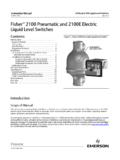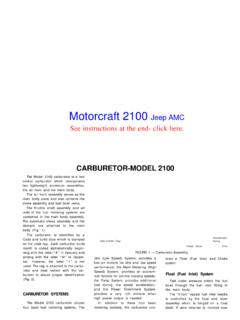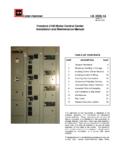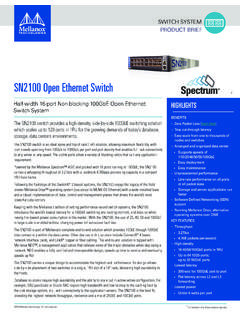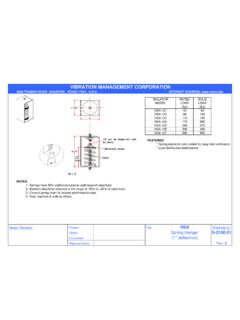Transcription of Permanent Epoxy Negative Photoresist
1 SU-8 2000 Permanent Epoxy Negative PhotoresistPROCESSING GUIDELINES FOR:SU-8 2100 and SU-8 2150SU-8 2000is a high contrast, Epoxy based Photoresist designed for micromachining and other microelectronic applications, where a thick, chemically and thermally stable image is desired. SU-8 2000 is an improved formulation of SU-8, which has been widely used by MEMS producers for many years. The use of a faster drying, more polar solvent system results in improved coating quality and increases process throughput. SU-8 2000 is available in twelve standard viscosities.
2 Film thicknesses of to >200 microns can be achieved with a single coat process. The exposed and subsequently thermally cross-linked portions of the film are rendered insoluble to liquid developers. SU-8 2000 has excellent imaging characteristics and is capable of producing very high aspect ratio structures. SU-8 2000 has very high optical transmission above 360 nm, which makes it ideally suited for imaging near vertical sidewalls in very thick films. SU-8 2000 is best suited for Permanent applications where it is imaged, cured and left on the GuidelinesSU-8 2000 Photoresist is most commonly exposed with conventional UV (350-400 nm) radiation, although i-line (365 nm) is the recommended wavelength.
3 SU-8 2000 may also be exposed with e-beam or x-ray radiation. Upon exposure, cross-linking proceeds in two steps (1) formation of a strong acid during the exposure step, followed by (2) acid-catalyzed, thermally driven Epoxy cross-linking during the post exposure bake (PEB) step. A normal process is: spin coat, soft bake, expose, PEB, followed by develop. A controlled hard bake is recommended to further cross-link the imaged SU-8 2000 structures when they will remain as part of the device. The entire process should be optimized for the specific baseline information presented here is meant to be used as a starting point for determining a process.
4 SU-8 2000 Features High aspect ratio imaging to > 200 m film thickness in a single coat Improved coating properties Faster drying for increased throughput Near UV (350-400 nm) processing Vertical sidewalls10 um features, 50 um SU-8 2000 PretreatHard Bake (cure)optionalRemovaloptionalProcess FlowCoatExposeEdge Bead Removal (EBR)Soft BakeDevelopPost Exposure Bake (PEB)Rinse and DryTHICKNESSSOFT BAKE TIMES (65oC)*(95oC)micronsminutesminutes100 - 15020 - 30160 - 225530 - 45230 - 2705 - 745 - 60280 - 550760 - 1207 - PreparationTo obtain maximum process reliability, substrates should be clean and dry prior to applying SU-8 2000 resist.
5 For best results, substrates should be cleaned with a piranha wet etch (using H2SO4& H2O2) followed by a de-ionized water rinse. Substrates may also be cleaned using reactive ion etching (RIE) or any barrel asher supplied with oxygen. Adhesion promoters are typically not required. For applications that include electroplating, a pre-treatment of the substrate with MCC Primer 80/20 (HMDS) is 2000 resists are available in twelve standard viscosities. This processing guideline document addresses two products: SU-8 2100 and SU-8 2150.
6 Figure 1. provides the information required to select the appropriate SU-8 2000 resist and spin conditions to achieve the desired film Program1.) Dispense 1ml of resist for each inch (25mm) of substrate ) Spin at 500 rpm for 5-10 seconds with acceleration of 100 ) Spin at 2000 rpm for 30 seconds with acceleration of 300 BakeA level hotplate with good thermal control and uniformity is recommended for use during the Soft Bake step of the process. Convection ovens are not recommended. During convection oven baking, a skin may form on the resist. This skin can inhibit the evolution of solvent, resulting in incomplete drying of the film and/or extended bake times.
7 Table 2. shows the recommended Soft Bake temperatures and times for the various SU-8 2000 products at selected film : To optimize the baking times/conditions, remove the wafer from the hotplate after the prescribed time and allow it to cool to room temperature. Then, return the wafer to the hotplate. If the film wrinkles , leave the wafer on the hotplate for a few more minutes. Repeat the cool-down and heat-up cycle until wrinkles are no longer seen in the 2. Soft Bake Times Table 1. SU-8 2000 Viscosity SU-8 2000 % Solids Viscosity (cSt) Density (g/ml)2100 Bead Removal (EBR)During the spin coat process step, a build up of Photoresist may occur on the edge of the substrate.
8 In order to minimize contamination of the hotplate, this thick bead should be removed. This can be accomplished by using a small stream of solvent (MicroChem s EBR PG) at the edge of the wafer either at the top or from the bottom. Most automated spin coaters now have this feature and can be programmed to do this removing any edge bead, the photomask can be placed into close contact with the wafer, resulting in improved resolution and aspect 1. SU-8 2000 Spin Speed versus Thickness 0501001502002503003504004505005506006507 00750800500100015002000250030003500 Spin Speed (rpm)Film Thickness (um) SU-8 2150SU-8 Cauchy Coefficients (uncured)Optical ParametersThe dispersion curve and Cauchy coefficients are shown in Figure 3.
9 This information is useful for film thickness measurements based on ellipsomety and other optical 3. Cauchy CoefficientsTHICKNESSPEB TIME (65oC)*PEB TIME (95oC)micronsminutesminutes100 - 15010 - 12160 - 225512 - 15230 - 270515 - 20280 - 550520 - 305* Optional step for stress 3. Exposure DoseRELATIVE Tin - - - 2 XNickel - - - - 2 XTable 4. Exposure Doses for Various SubstratesPost Exposure Bake (PEB)PEB should take place directly after exposure. Table 5. shows the recommended times and temperaturesNote: After 1 minute of PEB at 95 C, an image of the mask should be visible in the SU-8 2000 Photoresist coating.
10 If no visible latent image is seen during or after PEB this means thatthere was insufficient exposure, heating or 5. Post Exposure Bake TimesExposureTo obtain vertical sidewalls in the SU-8 2000 resist, we recommend the use of a long pass filter to eliminate UV radiation below 350 nm. With the recommended filter (PL-360-LP) from Omega Optical ( ) or Asahi Technoglassfilters V-42 plus UV-D35 ( ), an increase in exposure time of approximately 40% is required to reach the optimum exposure : With optimal exposure, a visible latent image will be seen in the film within 5-15 seconds after being placed on the PEB hotplate and not before.





